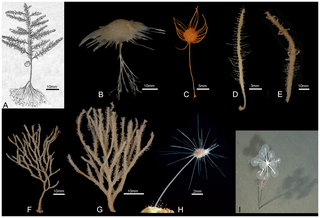
Cladorhiza is a genus of carnivorous sponges, comprising around 40 species found in oceans around the world. Cladorhiza is the type genus of the family Cladorhizidae.

Chondrocladia is a genus of carnivorous demosponges of the family Cladorhizidae. Neocladia was long considered a junior synonym, but has recently become accepted as a distinct genus.

Goldman's woodrat is a rodent species in the family Cricetidae. It is found only in Mexico throughout the Mexican Plateau, stretching from southeastern Chihuahua to southern San Luis Potosí and northern Querétaro. The plateau is an average 5,988 ft. above sea level and covers a land area of 232,388 sq. miles.

Cavefish or cave fish is a generic term for fresh and brackish water fish adapted to life in caves and other underground habitats. Related terms are subterranean fish, troglomorphic fish, troglobitic fish, stygobitic fish, phreatic fish and hypogean fish.

Holmesina is a genus of pampathere, an extinct group of armadillo-like creatures that were distantly related to extant armadillos. Like armadillos, and unlike the other extinct branch of megafaunal cingulates, the glyptodonts, the shell was made up of flexible plates which allowed the animal to move more easily. Holmesina species were herbivores that grazed on coarse vegetation; armadillos are mostly insectivorous or omnivorous.

Chondrocladia lyra, also known as the lyre sponge or harp sponge, is a species of carnivorous deep-sea sponge first discovered off the Californian coast living at depths of 10,800–11,500 feet (3,300–3,500 m) by Welton L. Lee, Henry M Reiswig, William C. Austin, and Lonny Lundsten from the Monterey Bay Aquarium Research Institute (MBARI).

Cladorhizidae is a family of carnivorous demosponges found in deep-sea environments worldwide. These sponges are known for their unique feeding structures and predatory behavior, as they capture and consume small animals such as crustaceans.
Cladorhiza caillieti is a carnivorous sponge of the family Cladorhizidae described in 2014 from specimens collected from the Juan de Fuca Ridge off the coast of Vancouver Island. It feeds on small crustaceans such as amphipods and copepods. C. caillieti is an elongate, bottlebrush-shaped sponge with filaments projecting from a main stem, and ranges from 7 to 9 cm in height. The specific epithet honors Dr. Gregor M. Cailliet of the Moss Landing Marine Laboratories.
Gregor Michel Cailliet is an American scientist who studies the ecology of marine fishes. He is professor emeritus at Moss Landing Marine Laboratories, part of The California State University, having officially retired in 2009.
Cladorhiza evae is a species of carnivorous sponge native to hydrothermal vents in the Gulf of California.
Axoniderma is a genus of carnivorous demosponges in the family Cladorhizidae.
Jean Vacelet is a French marine biologist who specialises in the underwater fauna of the Mediterranean. After earning his licence at the Faculté des Sciences de Marseille and learning to dive in 1954, he specialised in the study of sponges at the Marine station of Endoume, and there he has stayed faithful to both sponges and place for more than half a century. His research has included all aspects of sponges: taxonomy, habitat, biology, anatomy, their bacterial associations, and their place in the evolution of multi-celled animals. He has studied them not only in the Mediterranean but in the Indian Ocean and the Pacific. Exploration of underwater grottoes, together with Jacques Laborel and Jo Hamelin, revealed the existence of sponges dating from very ancient geological periods and the unexpected existence of carnivorous sponges, and surprisingly, the grottoes in some ways mimicked life at much greater depths.
Michelle Kelly, also known as Michelle Kelly-Borges, is a New Zealand scientist who specialises in sponges, their chemistry, their evolution, taxonomy, systematics, and ecology.
2023 in arthropod paleontology is a list of new arthropod fossil taxa, including arachnids, crustaceans, trilobites, and other arthropods that were announced or described, as well as other significant arthropod paleontological discoveries and events which occurred in 2023.
Axoniderma australis is a species of demosponge in the family Cladorhizidae. It is known from type specimens found off the coasts of Tasmania and New South Wales.
Axoniderma poritea is a species of demosponge in the family Cladorhizidae. It is known from type specimens found on the east coast of Australia.
Axoniderma hubbsi is a species of demosponge in the family Cladorhizidae. It is known from type specimens found in the northeast Pacific Ocean.
Axoniderma kensmithi is a species of demosponge in the family Cladorhizidae. It is known from type specimens found in the Pacific Ocean off the coast of California.






